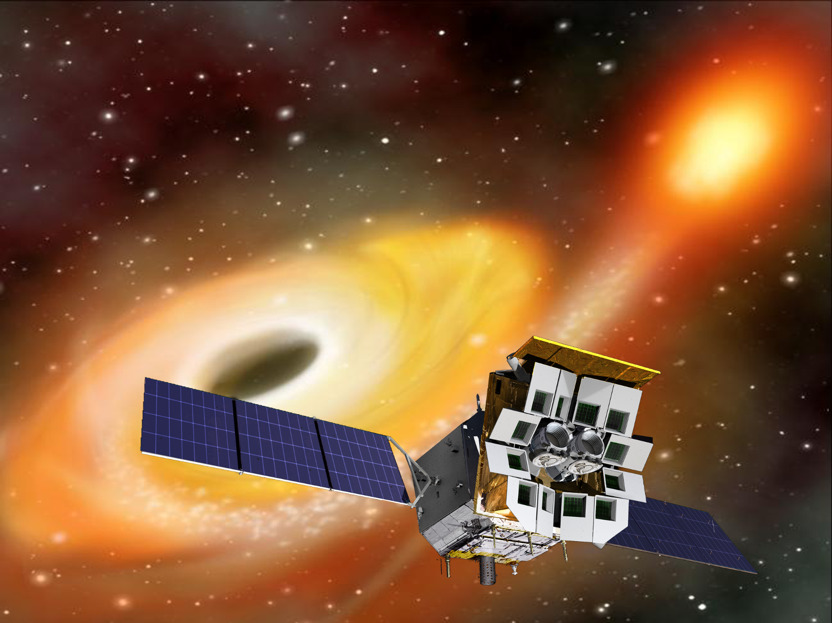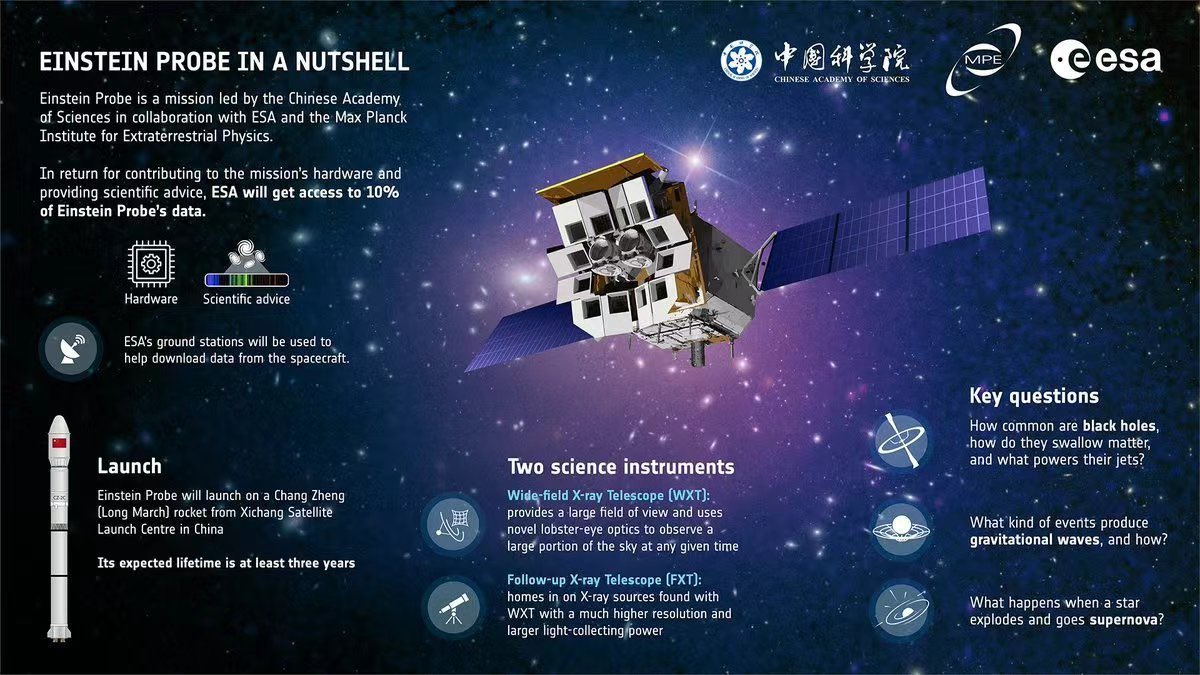Successful launch of the Einstein Probe to look for extreme X-ray transients
- The mission will explore the sky for 3 years to better understand the most extreme objects in the Universe, such as neutron stars and black holes
- It is equipped with two new generation X-ray instruments, one with high sensitivity, and another one with a large field of view
- The IEEC researcher at the Institute of Space Sciences (ICE-CSIC) Nanda Rea is highly involved in the mission as a member of the Science Team and of the Management Committee

Caption: Einstein Probe artist impression.
Credits: Chinese Academy of Sciences (CAS).
The Einstein Probe space-mission, led by the Chinese Academy of Sciences (CAS), has been launched today, 9 January 2024, at 08:03 CET on a Chang Zheng (Long March) rocket from the Xichang Satellite Launch Centre in China to survey the sky and hunt for blasts of X-ray light coming from new astronomical objects. The project is a CAS collaboration with the European Space Agency (ESA) and the Max Planck Institute for Extraterrestrial Physics (MPE), in which researchers from the Institute of Space Studies of Catalonia (IEEC — Institut d’Estudis Espacials de Catalunya) at the Institute of Space Sciences (ICE-CSIC) participate.
It will be detecting high energy flashes of cataclysmic cosmic events, including tidal disruption events (stars pulled apart by supermassive black holes), supernovae, neutron stars and black holes, and high-energy, electromagnetic counterparts of gravitational wave events.
The IEEC researcher at the ICE-CSIC Professor Nanda Rea is a member of the ESA Einstein Probe Science Team, Chair of the Science Topical Panel on Compact Objects (studying neutron stars, black holes, white dwarfs, their environments and Galactic populations), as well as part of the Einstein Probe Management Committee, which determines the scientific policy of the mission.
In addition, ICE-CSIC and IEEC postdoctoral researchers Dr Francesco Coti Zelati and Dr Alessio Marino are also involved as associated members to the Science Topical Panel on Compact Objects.
Equipped with two new generation X-ray instruments, with high sensitivity and a very wide view, the Einstein Probe will help scientists answer questions like: How common are black holes and how do they swallow matter? What kind of events produce gravitational waves? What happens when a star explodes and goes supernova?
X-ray light from astronomical sources is very unpredictable. However, it carries fundamental information about them. X-rays are associated with collisions between neutron stars, supernova explosions, matter falling into black holes or hyper-dense stars, or high-energy particles being spewed out from discs of blazing material circling such mysterious objects.
“Many new high energy flashes will be discovered everyday in real-time, such as compact binary mergers, supernovae, black holes and neutron stars, magnetars, etc. Hopefully, in connection with other multi-band and gravitational wave facilities. This will allow us a unique view to the first phases of the most extreme events in the Universe,” says Nanda Rea.
In return for contributing to the development of this mission and the definition of its scientific goals, ESA will get access to 10% of the data generated by Einstein Probe’s observations.

Optics inspired by lobster’s eyes
Einstein Probe will improve our understanding of cosmic events by discovering new sources and monitoring the variability of objects shining in X-rays all over the sky.
In order to do so, the mission uses a novel type of optics, inspired by the eyes of lobsters, which allows a large field of view. In three orbits around Earth, Einstein Probe is able to observe almost the entire night sky. This sets the mission apart from ESA’s other missions like XRISM and Athena –in which the ICE-CSIC and IEEC are also involved–, which have a higher spectral and spatial resolution but a limited field of view.
To achieve its scientific goals, the Einstein Probe is equipped with two instruments with high sensitivity and the ability to observe large areas of the sky: the Wide-field X-ray Telescope (WXT) and the Follow-up X-ray Telescope (FXT).
The WXT instrument consists of 12 modules, together creating a view of 3600 square degrees, thanks to a technology inspired by the eyes of the lobsters. These are made up of parallel square pores arranged on a sphere that reflect light towards a spherical centre. Hundreds of thousands of square tubes guide X-rays down to a CMOS light detector.
The FXT instrument instead is composed of two identical units, with a smaller field of view but higher sensitivity. The mirror module consists of 54 gold coated shells. FXT is a great tool to quickly follow-up X-ray flashes detected by the WXT, as it has a much larger light collecting power and much higher resolution.
After a period of Performance Verification and Calibration (4 to 5 months), where the ICE-CSIC and IEEC members will be heavily involved to prepare the first light scientific releases, the Einstein Probe will start releasing publicly the positions of new high energy transients, to allow multi-band follow-ups.
Contacts
IEEC Communication Office
Barcelona, Spain
E-mail: comunicacio@ieec.cat
Lead Researcher at the IEEC
Barcelona, Spain
Nanda Rea
Institute of Space Studies of Catalonia (IEEC)
Institute of Space Sciences (ICE-CSIC)
E-mail: rea@ieec.cat, rea@ice.csic.es
About the IEEC
The Institute of Space Studies of Catalonia (IEEC — Institut d’Estudis Espacials de Catalunya) promotes and coordinates space research and technology development in Catalonia for the benefit of society. IEEC fosters collaborations both locally and worldwide and is an efficient agent of knowledge, innovation and technology transfer. As a result of more than 25 years of high-quality research, done in collaboration with major international organisations, IEEC ranks among the best international research centres, focusing on areas such as: astrophysics, cosmology, planetary science, and Earth Observation. IEEC’s engineering division develops instrumentation for ground- and space-based projects, and has extensive experience in working with private or public organisations from the aerospace and other innovation sectors.
The IEEC is a non-profit public sector foundation that was established in February 1996. It has a Board of Trustees composed of the Generalitat de Catalunya, Universitat de Barcelona (UB), Universitat Autònoma de Barcelona (UAB), Universitat Politècnica de Catalunya · BarcelonaTech (UPC), and the Spanish Research Council (CSIC). The IEEC is also a CERCA centre.
